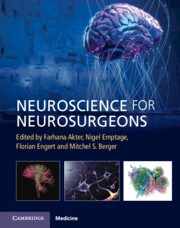Book contents
- Neuroscience for Neurosurgeons
- Neuroscience for Neurosurgeons
- Copyright page
- Contents
- Contributors
- Section 1 Basic and Computational Neuroscience
- Chapter 1 Neuroanatomy
- Chapter 2 Cerebral Autoregulation
- Chapter 3 Neuroimmune Interactions
- Chapter 4 Anatomy and Physiology of the Neuron
- Chapter 5 Synaptic Transmission
- Chapter 6 Sensory Pathways
- Chapter 7 Somatosensory and Somatic Motor Systems
- Chapter 8 Neuron Models
- Chapter 9 An Introduction to Artificial Intelligence and Machine Learning
- Chapter 10 Artificial Intelligence in Neuroscience
- Chapter 11 Probability and Statistics
- Section 2 Clinical Neurosurgical Diseases
- Index
- References
Chapter 8 - Neuron Models
from Section 1 - Basic and Computational Neuroscience
Published online by Cambridge University Press: 04 January 2024
- Neuroscience for Neurosurgeons
- Neuroscience for Neurosurgeons
- Copyright page
- Contents
- Contributors
- Section 1 Basic and Computational Neuroscience
- Chapter 1 Neuroanatomy
- Chapter 2 Cerebral Autoregulation
- Chapter 3 Neuroimmune Interactions
- Chapter 4 Anatomy and Physiology of the Neuron
- Chapter 5 Synaptic Transmission
- Chapter 6 Sensory Pathways
- Chapter 7 Somatosensory and Somatic Motor Systems
- Chapter 8 Neuron Models
- Chapter 9 An Introduction to Artificial Intelligence and Machine Learning
- Chapter 10 Artificial Intelligence in Neuroscience
- Chapter 11 Probability and Statistics
- Section 2 Clinical Neurosurgical Diseases
- Index
- References
Summary
Viewing the neuron as an electrical system gives an easy handle into modeling the generation and transmission of action potentials. In the simplest version of this framework, the entire neuron can be viewed as having a single membrane potential. Models built on this assumption are termed “single-compartment” models. A more detailed assessment of the spatial variation in membrane potential gives rise to “multi-compartment” models. We now look at the basic electrical properties of spiking neurons that are essential to most models
- Type
- Chapter
- Information
- Neuroscience for Neurosurgeons , pp. 134 - 145Publisher: Cambridge University PressPrint publication year: 2024



